
Church Memorials
As you enter the Church porch you will see on your right the War Memorials to those from our village who died during the 1st and 2nd World Wars. Amongst the names is that of Sergeant Arthur Spowage, who lived at “The Meadows” in Elston. He served in the Grenadier Guards during the 1st World War and was awarded the Distinguished Conduct Medal for conspicuous gallantry in 1915. “When his platoon commander was wounded early in an attack, he took charge, led the platoon forward with great determination under heavy fire, capturing several machine guns and killing the teams. Seeing that the flank of the battalion was insecure, he led the platoon on his own to fill the gap. He consolidated his position under heavy fire and saved a critical situation by his courage and good leadership.” Sadly Arthur died in action on 30th March 1918 aged 27 years. Before he enlisted he was serving as a Nottingham police officer.
Another local war hero was Corporal Frederick Hickman, born in Elston in 1882 who received the Military Medal but sadly was killed a few months before the end of the War in 1918. His father John died when Frederick was 4 years and his mother Jane remarried to John Wilkinson the village wheelwright and local Methodist preacher living in Low Street. Frederick emigrated to Canada in 1908 and became a farmer. He enlisted in the Canadian Overseas Expeditionary Force in 1916 and was killed in action near Arras on 27th August 1918 leaving a wife and a child in Canada. He served in the Canadian Mounted Police.
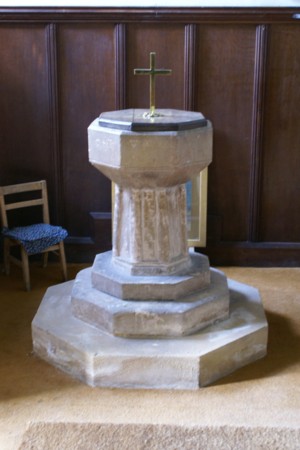
As you enter the Church you will pass a small 14th century octagonal font on your left which still has signs of the original staple and hinge of its original cover. Immediately before you stands a large arch at the western end of the nave decorated on both sides and affixed to it are stone armorial shields of the Lascelles family and their alliances.
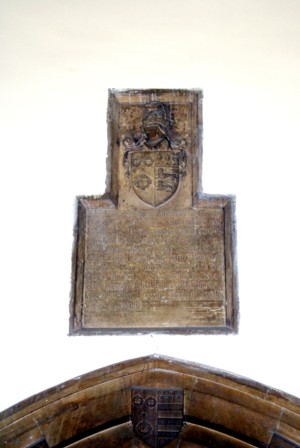
At the top of the tower arch is a plaque to John Lascelles, 3rd son of George Lascelles of Guileford and Sturton. This is surmounted by a shield and visor. He married Elizabeth, only daughter and heir of Bartholomew Methley. There is no date on this stone but John Lascelles died in 1616 and his wife in 1632.
The inscription reads:-
“John Lascells Esquire, third sonne of George Lascells, of Guileford and Sturton, Esq, and brother to Sir Brian Lascells Knight, married Elizabeth the sole daughter and heir of Bartholomew Methley of Elston Esq, and had issue- George Lascells Who married Anne the daughter of Gervis Wirral of Levensall in the county of York Esq and she had issue, Anne Lascells, Hellen Lascells, Margaret Lascells and Gervis Lascells.”
Members of the family are buried in the Church, beneath the Tower, underneath the wooden parquet flooring. This area was sometimes called the “Lascelles Chapel”. In the will of George Lascelles dated 1673 he requested to be buried “in the aisle of Elston Church belonging to the Lascelles family and as near his father and grandfather as possible”. It was not only the Lascelles who were buried in the south aisle, for in 1479 John Methley, a lawyer left money for the aisle, also known as the aisle of John the Baptist, to be lengthened by nine feet so that he might be buried there.
During the Civil War the Lascelles family appears to have been divided in their support for King Charles. There is a story that George Lascelles, who had fought for the King, apparently changed sides at the Battle of Worcester in 1651 and
pursued the future Charles II from the battlefield to Boscobel House, where Charles hid in an oak tree in the grounds, later escaping on horseback with the lady of the house, Jane Lane. Charles was led to safety by John Lascelles, her cousin, and the story goes that George Lascelles picked up some acorns from the oak tree and later planted them in front of Elston Hall.
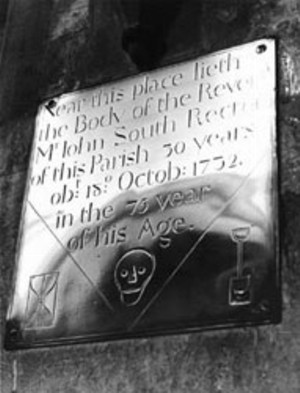
To the side of the arch on the wall you will see a striking and poignant decorative copper plaque to John South, Rector of Elston who died in 1732. This is a typical eighteenth century representation of our mortality showing the hourglass, skull and spade. John was ordained priest on 29th December 1690 and was licensed to Elston on 14th May 1702. He had a large collection of theological books dating from the 16th and 17th centuries and the remains of this library are now kept preserved in Nottingham University. John South gives a graphic account on 7th March 1716 in Elston of what appears to be connected with the Aurora Borealis or Northern Lights -
“I observed in the North West a long and broad stream of light, issuing out of a darkish cloud, like the beams of the setting sun in a drizzling evening... Presently after some other streams of light issued out of another cloud near to the former with a very unusual light and with a variety of colours black, blue, flame colour yellow etc and so more and more till all that part of the heavens was so overspread. During the whole time never was seen such contentions it were as betwixt these meteors: being all in confusion and darting one against another with an incredible force and swiftness for about
an hour and a half....“
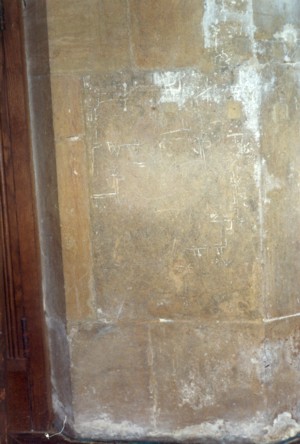
Charles Darwin, author of the Origin of Species, refers in one of his letters to a friend in 1839 of a discovery made in the rectory grounds of the Rev John South by William Darwin, his great grandfather, of an Icthyosaurus in a piece of stone that had provided a small platform by a well according to Stukeley’s 1719 account. Charles wrote that as a result of this Darwin discovery "we have a right of hereditary descent to be naturalists, and especially geologists." On the wall below the copper plaque is a piece of graffiti made by a child in the 17th century when this part of the Church was used for teaching school children.

You can see the name Richard Foottit in the stonework at the top of the right hand side of the west window. This is an unusual memorial in the Church. Foottit describes himself as “Clark”. In 1729 the west window had been blocked up and was eventually reglazed and reopened. The appearance of his name marks the occasion when the window was reopened. Richard would have been the Parish Clerk and would have assisted the Rector in the administration of the Church. At the base of this window on the left hand side you can see some 17th century graffiti showing the letter R and the date 1686.
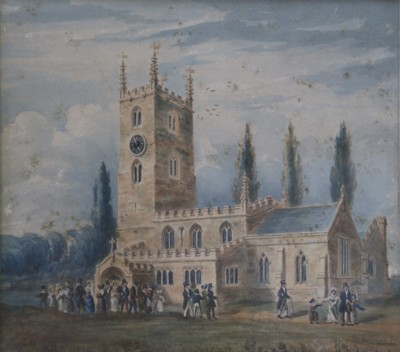
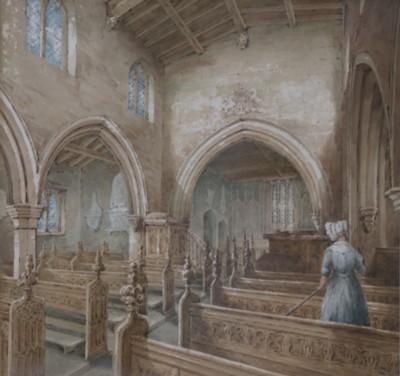
As you pass to the north aisle there are two fine John Tuke pictures on the west wall, of the interior and exterior of the Church in Georgian times. Among the differences in the interior of the Church are positions of the wall memorials in the north aisle. As you now enter the north aisle you will see on the south and west wall, the very sad monuments to three of the children of William Brown Darwin. William succeeded his Uncle, Robert Waring Darwin and inherited the Elston Estate and lived at Elston Hall. He was married to Elizabeth de St Croix and had 7 children, 4 of whom died young. Three of them died tragically at the ages of 13, 14 and 15 years between the years 1835 to 1838. The cause of death for certainly one, if not all, of them was “lingering consumption” (now known as Tuberculosis), so described because the illness wastes away its victims or “consumes” them. It was a particularly vehement and contagious disease in England in the 19th century which thrived in overcrowded or unsanitary conditions in poor areas of large cities.
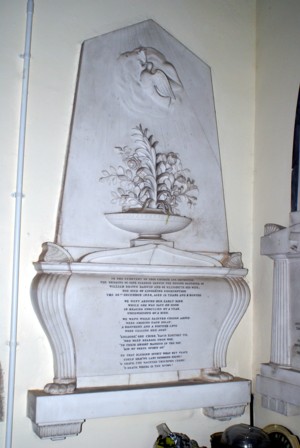
The memorials were sculpted by Thomas Tyley of Bristol (born 1789). There was a big demand for religious monuments in the 19th century and Tyley was a leading marble sculptor in Bristol. The one to Jane Eleanor Darwin on the south wall is set into a decorative sarcophagus and is surmounted by an urn with flowers, over which is a dove carrying a lily. On the west wall, the one to William Waring Darwin has a decorative urn over the inscription and two angels holding a crown above. The one to Elizabeth has fluted columns flanking the inscription and is surmounted by a well sculpted seated woman.
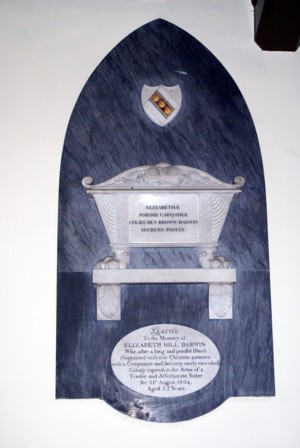
At the west end of the south aisle is an oval inscription tablet to Elizabeth Hill Darwin , sister of William Brown Darwin, by Michael Taylor of York (1760 -1846). Taylor came from Felton in Northumberland and did a considerable amount of carving for York Minster including the statute of Henry VI on the screen and the Percy and Vavasour figures on the west front carved in 1802. In this instance he has carved a decorative sarcophagus topped with a decorative shield.
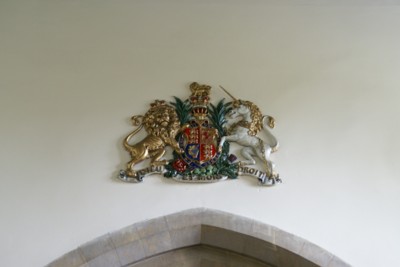
Moving up to the chancel and Altar you will see the brightly painted Royal Coat of Arms (erected to mark the Monarch’s position as Head of the Church of England) which fortunately survived Victorian church restoration. To the left of the altar is a bust and plaque of Erasmus Darwin high up on the north wall. This was unveiled on 18th April 2002 to mark the 200th anniversary of his death. He was born in 1731 and was a leading figure of his age who became a noted physician, so noted in fact that he was offered the post of Royal Physician to George III, which he surprisingly declined. He was also a poet and scientist and is perhaps our most celebrated villager. He lived at Elston Hall and was a founder member of the Lunar Society, a group of liberal-minded thinkers and industrialists who met on moonlit nights to exchange ideas and develop new inventions. They included Josiah Wedgwood, James Watt, Joseph Priestly and Matthew Boulton. This Society is widely recognised as a major catalyst behind the Industrial Revolution in this country.
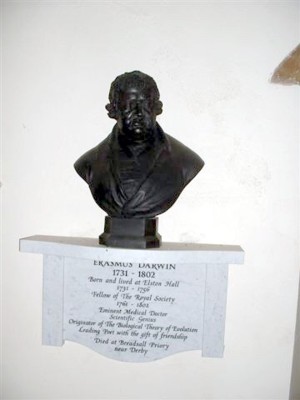
Erasmus was also an obsessive innovator whose inventions included a horizontal windmill, a carriage that would not tip over, a speaking machine, a canal lift for barges, a copying machine, an artesian well, and the steering technique still used in modern cars. It is even said that in 1791 he predicted the coming of the steam engine in the following lines of poetry
“Soon shall thy arm, unconquered steam afar
Drag the slow barge or drive the rapid car”
One amusing story recounts the visit of a villager who brought a message for Erasmus and, just as he waited in the kitchen for a reply, suddenly heard a voice which appeared to come from the burning fireplace asking for more coal. The terrified man fled the house not knowing that it was the inventive doctor speaking through a pipe he had laid to connect his study with the kitchen. Erasmus was the first person to fully understand and explain the process of photosynthesis in plants and to describe the formation of clouds. He translated Linnaeus’s Systema Vegetabilium - the system of plant classification that forms the basis of modern botany. He was the grandfather of Charles Darwin, author of “The Origin of Species” and Erasmus’s last work “The Temple of Nature,” published posthumously in 1803, anticipated Charles’s theory of
evolution.
Erasmus appears to have been a larger than life character. He had a voracious appetite and later in his life a semi circular hole had to be cut into the dining table to accommodate his protruding stomach. He died in 1802 in Derby and is buried in the nave of Breadsall Parish Church. During alterations of the Church in 1877, his coffin was exposed and his great-grand daughter Elizabeth Wheler reported “My grandfather’s coffin had burst open and his remains were visible and in perfect preservation. He was dressed in a purple velvet dressing gown and his features unchanged”.
As you move down the chancel you may be walking over the grave of William Perrie, Vicar of Cotham, (a village near Elston), who was buried in the chancel after his funeral service here at All Saints Church on 21st March 1654. If you look upwards you will see hooks affixed to the wooden roof from which the old oil lamps used to hang in the chancel before their replacement by electric lights in 1933.
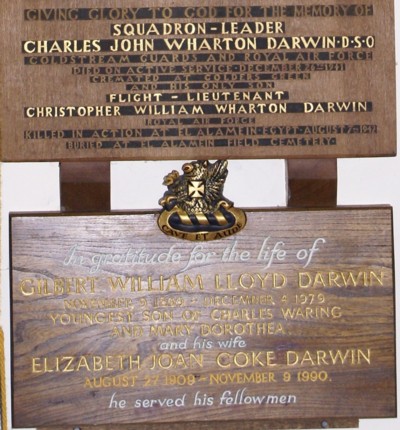
Make your way past the wooden lectern into the south aisle where a wooden memorial can be seen on the south wall to Squadron Leader John Darwin DSO and his son Christopher, both killed in the 2nd World War. Christopher died shortly after John at El Alamein in August 1942. John was the eldest son of Colonel Charles Waring Darwin and joined the 2nd Battalion Coldstream Guards. He was first stationed at Windsor Castle as King’s Guard. In the middle of the night a guardsman thought he saw a ghost and fired a shot at it. An infuriated George V stuck his head out of the window and asked what the hell was going on. John explained about the ghost. Unfortunately the precise wording of the King’s reply is not known but evidently it showed a forceful command of the English language. John was sent to France in 1914 at the
outbreak of War and was wounded. In 1916 he transferred to the Royal Flying Corps where he formed and commanded No. 87 Squadron and was awarded the DSO. In 1919 he accompanied Winston Churchill, the Secretary of State for War, to Paris for the Peace Talks. He later joined the Intelligence Service (MI6) and became heavily involved in the setting up of Bletchley Park, travelling extensively abroad setting up radio transmitters and briefing agents. On one occasion John turned up at Tilbury Docks in deepest mourning and accompanied the coffin of a friend who had sadly died while they were on holiday together on the continent. A car whisked John away and the coffin contained not a corpse but a cylinder of gas which the Germans had planned to use in the War. In 1940 he left Bletchley Park and the Secret Service and was back in the RAF as a Squadron Leader and was killed a year later.
Commemorative Windows
The following people are commemorated on the 18 windows of the Parish Church.
W1 - Charlotte M.C. Darwin
W2 - No Dedication
W3 - No Dedication
W4 - John Lloyd Wharton
W5 - John Lloyd Wharton
W6 - John Lloyd Wharton
W7 - No Dedication
W8 - Harry Cazalet Harrison
W9 - John Thorpe
W10 - Harry Martin, Ethel Martin
W11 - Jack Evans, Ruth Evans
W12 - Richard Derek Clare
W13 - Robert Alvey Darwin
W14 - June Walker, Clarence Herbert Walker, Alice Walker
W15 - Archibald C. Wood, Phyllis M. Wood
W16 - Donald T. Campbell, Joan P. Campbell
W17 - No Dedication
W18 - Trevor Wall
W19 - No Dedication
W.jpg)
W1 The east window behind the Altar, in memory of Charlotte Darwin, was erected by Francis Darwin, the husband of Charlotte. This beautiful window was designed by three men who produced magnificent stained glass windows from 1855 onwards - Clement Heaton (1824-1882), James Butler (1830-1913), and Robert Bayne (1837-1915). Their company was one of the leading firms of Gothic Revival whose work was commissioned by the leading Victorian architects. From 1862 Robert Bayne became their sole designer and his windows show strong colour and are often recognisable by the inclusion of at least one figure with Bayne’s features and long beard. The extended range of colours in the stained glass windows were a result of Clement Heaton's research into pigments. Their work can be found in many places across the UK including Westminster Abbey, Peterborough Cathedral, Emmanuel College, Cambridge and Kings College Hospital, London.

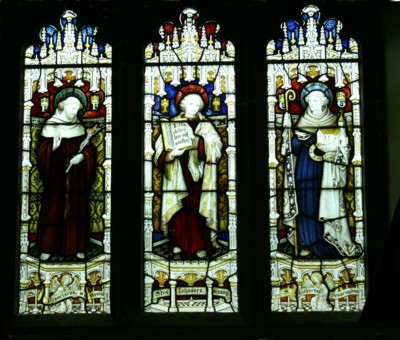
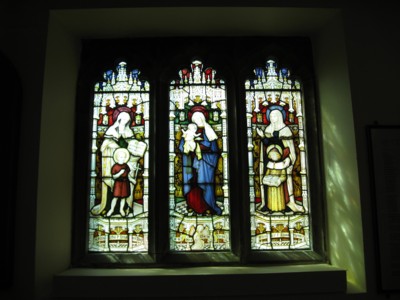
W4, W5, and W6 are dedicated to John Lloyd Wharton, MP for Durham (1871 -1874) and also for Ripon (1886 -1906). He was a director of the North Eastern Railway and father of Mary Dorothea Darwin who erected this memorial. Wharton married Susan Frances Duncombe Shafto in 1870 but she died in 1872. He died on 11th July 1912 in Yorkshire. One of the bells in the Church tower was donated in 1912 in his memory by his daughter and is inscribed ‘To the Glory of God and in Loving Memory of John Lloyd Wharton’.
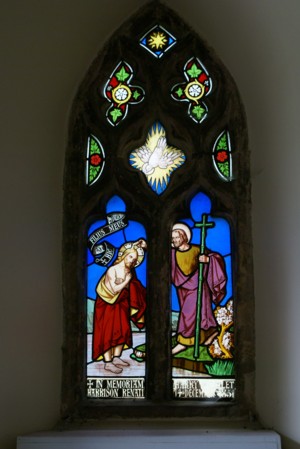
W8 Harry Cazalet Harrison is thought to be a son of the Rev. Henry Robert Harrison, Rector of Elston (1836-1855). Harry's death is shown as 14th December 1851 but it is not recorded in the Parish Burial Register. The Rector sadly died shortly afterwards in March 1853 aged only 50 years, leaving a widow and two children. He is buried in the Churchyard.
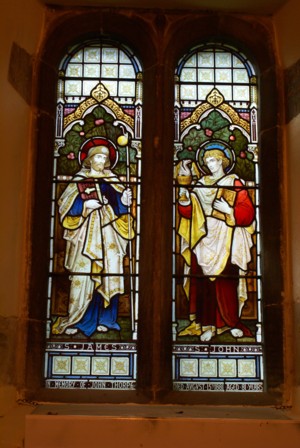
W9 John Thorpe lived in Elston Hall. He owned a very successful malting, flour, coal and wharfing business along the river Trent with his office situated in Millgate, Newark. He also owned a large steam mill on Farndon Road. John Thorpe died in 1881 and is buried in the Churchyard in a distinctive granite sarcophagus inscribed with celtic symbols. His brother James is buried in Coddington under a similar stone. A wooden pulpit was presented to the Church in his memory but it has not survived. In 1885 the Thorpe family business was taken over by Gilstraps.
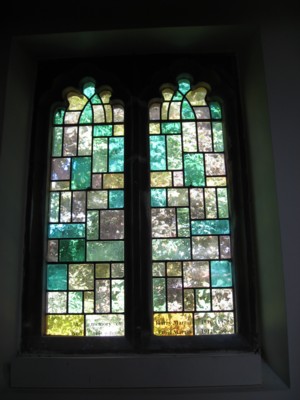
W10 Harry Martin and Ethel Martin. Harry Martin lived in Elston all his life. He took great pride in the village and its traditions, lending his help and active support to village activities throughout his life. He was a bell ringer in this Church for a number of years and loved the sound of the old church bells. Ethel Martin came to Elston to become a house servant to the Darwin family at Elston Hall. She was very loyal to this Church and each Sunday could be found in her usual place in the back pew.
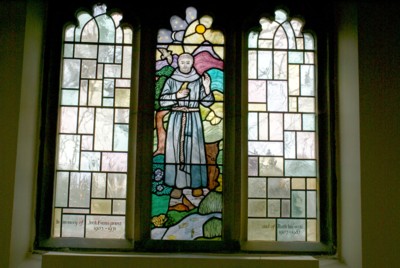
W11 This window is in memory of Rev. Arthur John Evans (1903 -1971) and his wife Ruth. Canon Jack, as he was affectionately known, was Rector of Elston from 1965 to 1971 and also a Canon at Southwell Minster until his death. He was a keen gardener, which might explain why the stained glass window of three lights in the north aisle of the Church depicts St Francis and the world of nature. The window is the work of Paul Quail of Norfolk, a leading stained glass artist and a Fellow of the Society of Master Glass Painters, who died in 2010. He used the traditional technique of lead and mouthblown glass, painted and stained with some aciding and enamels. His stunning designs, usually of an ecclesiastic theme, included a fine memorial window in the chapel of the Royal Agricultural College, Cirencester, three lights at Oundle School and the dazzling ‘Transfiguration’ in St Paul’s Church, West Bridgford in Nottingham . Fine examples of his work can also be seen in many Norfolk churches.
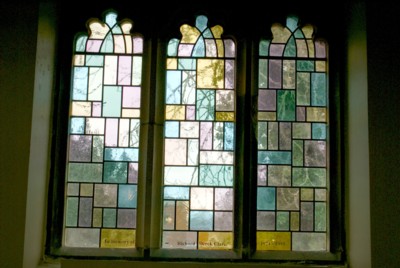
W12 Richard ‘Derek’ Clare, husband of Renee , came to Elston when he was made District Inspector for Barclays Bank. He was treasurer for many years of the Ann Darwin Almshouses and a loyal member of this Church. He died in 1999.

W13 Robert Alvey Darwin was born in 1826. He was the brother of Charlotte Maria Cooper Darwin. He inherited Elston on the death of his father in 1841. However, he died unmarried only six years later at the age of 21. He left the Elston Hall estate in his will to his brother-in-law, Francis Rhodes, on condition that he changed his surname to Darwin. This he did in 1850, but the headship of the family in the male line went to Robert Waring Darwin, Charles Darwin's father.
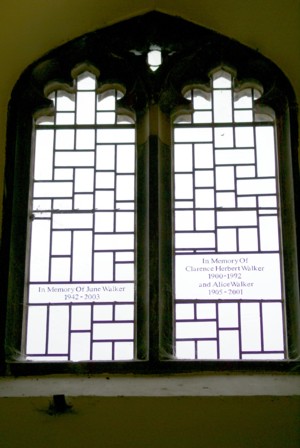
W14 June Walker, Clarence Herbert Walker, and Alice Walker. June Walker, wife of Ivor Walker a former
Chairman of Elston Parish Council, held the position of Parish Clerk for many years and also served on the Village Hall Committee. Clarence Walker played for Elston Football Club and was its secretary for a number of years. He was secretary of the Pig Club, going back to the days when most villagers kept pigs at the bottom of the garden, treasurer of the Friendship Club, and secretary of the Society of Oddfellows. Alice, wife of Clarence, was born in Elston and lived in the village all her life. She sang in the church choir and was a founder member of the Elston W.I.
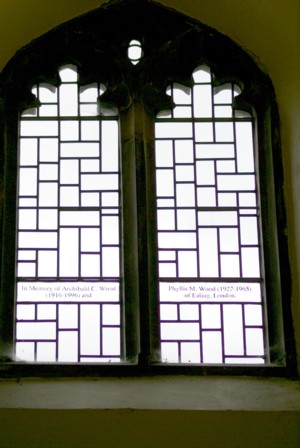
W15 Archibald Cuthill Wood, and Phyllis May Wood. Archie Wood and his wife Phyllis lived in Ealing in West London. Archie was a Fellow of the Royal Astronomical Society and became well known in this country and abroad for his fine refractor telescopes with hand ground glass lenses which he made in his workshop next to his house. He served in the RAF during the 2nd World War with John “Cats Eyes” Cunningham who, by the end of the Blitz in May 1941, had become a famous night fighter pilot. Phyllis served in the WRAF and her life was tragically cut short in her 40s.
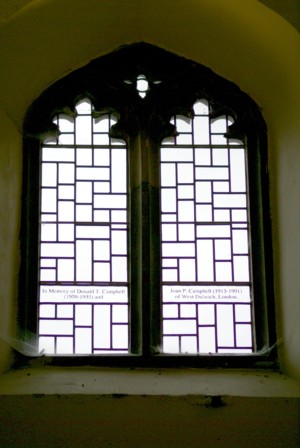
W16 Donald Taylor Campbell and Joan Patricia Campbell. Alderman Donald Campbell was Mayor of Lambeth in London in 1969 and followed in the footsteps of his maternal grandfather who was Mayor of Stafford. He served as a Lambeth Councillor for over 25 years. He was President of the Norwood Conservative Association, a Governor of Dulwich College (where he was at school), and an Estates Governor. He became President of the Alleyn Club and served many years as a Magistrate in London. He was granted the Freedom of the City of London in 1970. Joan, his wife, was Mayoress of Lambeth and became Vice President of the South East London Sector of the British Red Cross. She served as Vice President of the Friendly Almshouses.
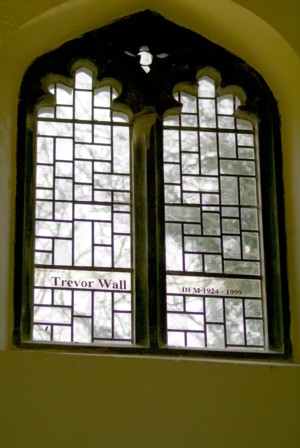
W18 Trevor Wall moved to Elston with his wife Ann after his retirement and was a member of the Church congregation and the Parochial Church Council. He had had an illustrious career as a navigator in the RAF, and had been awarded the Distinguished Flying Medal. After leaving the RAF he became a college lecturer in accountancy. He died in 1999 at the age of 75.
